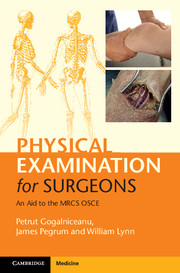Book contents
- Frontmatter
- Dedication
- Contents
- List of contributors
- Introduction
- Acknowledgments
- List of abbreviations
- Section 1 Principles of surgery
- Section 2 General surgery
- Section 3 Breast surgery
- Section 4 Pelvis and perineum
- Section 5 Orthopaedic surgery
- Section 6 Vascular surgery
- Section 7 Heart and thorax
- Section 8 Head and neck surgery
- 32 Examination of the ear
- 33 Examination of the nose
- 34 Examination of the throat
- 35 Oral and maxillofacial examination
- 36 Examination of the neck and thyroid
- Section 9 Neurosurgery
- Section 10 Plastic surgery
- Section 11 Surgical radiology
- Section 12 Airway, trauma and critical care
- Index
33 - Examination of the nose
from Section 8 - Head and neck surgery
Published online by Cambridge University Press: 05 July 2015
- Frontmatter
- Dedication
- Contents
- List of contributors
- Introduction
- Acknowledgments
- List of abbreviations
- Section 1 Principles of surgery
- Section 2 General surgery
- Section 3 Breast surgery
- Section 4 Pelvis and perineum
- Section 5 Orthopaedic surgery
- Section 6 Vascular surgery
- Section 7 Heart and thorax
- Section 8 Head and neck surgery
- 32 Examination of the ear
- 33 Examination of the nose
- 34 Examination of the throat
- 35 Oral and maxillofacial examination
- 36 Examination of the neck and thyroid
- Section 9 Neurosurgery
- Section 10 Plastic surgery
- Section 11 Surgical radiology
- Section 12 Airway, trauma and critical care
- Index
Summary
Checklist
WIPER
• Position and expose as for ear examination. Perform with headlight.
Physiological parameters
General inspection (from the front)
• Listen to the voice and breathing.
• Inspect face, eyes, lips and mouth.
External examination of the nose
Inspection:
• Front:
• symmetry: height, width, bony deformity, septal deviation
• scars: columella, lateral rhinotomy, Lynch-Howarth, bicoronal
• skin: erythema, rash, swelling, ulcer
• alar collapse
• Sides:
• profile: dorsal hump, saddling, tip ptosis
• Below:
• narrowing of external nasal valve
• triangularity
Palpate:
• Skin: quality
• Nasal bones: steps, fractures
• Nasal tip support and recoil
Patency:
• Misting test/nostril occlusion
• Cottle's manoeuvre
Internal examination of the nose
• Elevate tip.
• Inspect position of the caudal septum: dislocation/deviation.
• Inspect the external nasal valve.
• Anterior rhinoscopy with Thudicum's speculum: nasal vestibule, septal deviation, septal perforation, mucosa (rhinitic), turbinates (congested), polyps, papillomas, granulomas, tumours, ulcers, crusting, Little's area (prominent vessels), telangiectasia.
• Rigid nasendoscopy.
Oral examination
• Inspect and percuss the upper teeth for dental disease.
To complete the examination…
• Regional lymphadenopathy.
• Cranial nerve examination and ear examination if evidence of postnasal space lesion.
Examination notes
What features should be noted on general inspection?
Full aesthetic assessment of the nose is beyond the scope of this chapter. Start by examining from the front.
• Patients with bilateral nasal congestion have a typical hyponasal voice – make a note of this at the start of the consultation.
• Listen to the patient's breathing – a whistling sound may indicate a septal perforation or crust inside the nose.
• Note if the patient is mouth breathing.
• A long face with an open mouth in children is referred to ‘adenoid facies’ and may indicate adenoidal hypertrophy.
• A ‘frog face’ is caused by gross nasal polyposis resulting in a broadened nasal bridge.
• Look at the lips for telangiectasia, which may indicate hereditary haemorrhagic telangiectasia in a patient with epistaxis.
- Type
- Chapter
- Information
- Physical Examination for SurgeonsAn Aid to the MRCS OSCE, pp. 281 - 287Publisher: Cambridge University PressPrint publication year: 2015

